Republican Numismatic Studies Coins: Ides of March, Brutus & Cassius, Antony & Octavian, 44-42BC
 |
Links to Republican Numismatic Studies, Coins: Ides of March, Brutus & Cassius, Antony & Octavian:
- Discussion and Pictures of Coins: 44-42BC Ides of March to Phillipi, Crawford 480/507
- Reviews about early Republican numismatics
- Reviews about the middle period in Republican numismatics
- Revised dating for Imperatorial coinage from Bernhard Woytek's ’Arma et nummi’
- Other reviews on the Imperatorial period in Republican numismatics
Coins: 44-42BC, Ides of March to Phillipi, Crawford 480/507
Click on any photo to see that coin. Or click on the right-hand blue link to see the entire set.
44-42BC, Crawford 480/497, Issues of Octavian Antony Lepidus
Click for SLIDE SHOW of these coins
Click for DETAIL VIEW of these coinswww.flickr.com
![]()
44-42BC Cr480/497 Octavian Antony Lepidus
The first coin of this set, with a veiled head of Mark Antony on the obverse, shares its reverse with a 44BC portrait coin of Caesar. It did not take Antony long to get his picture on a coin just like Julius Caesar. The second triumvirate was formed with Lepidus and Octavian at the end of 43BC. Lepidus was always the quieter of the three triumvirs, and was also quiet in coinage. Although represented on the portrait gold coins, the only two common issues in his name were a quinarius with just his titles M.ANT.IMP.LEP.IMP. shared with Mark Antony, and a Lepidus portrait coin shared with Octavian. A 20 year old Octavian looks very youthful on his first portrait coin, although the first coin issued by Octavian may be the excessively rare Crawford 482 Venus / trophy and chariot denarius that was long thought to be one of Caesar’s own coins. The ghost of Julius Caesar reappears on a coin of Mark Antony, one of which in this set is a brockage with Antony’s head on both sides. I am sure he would have wanted it that way. As obverse brockages are the norm it is also very likely that it was Antony’s head on the obverse rather than Julius Caesar. The image of Julius Caesar was to be borrowed more often by Octavian in later years. Only one coin type of 43BC clearly shows all three triumvirs, Antony Octavian and Lepidus.
44-42BC, Crawford 485/494, Rome Mint, Ides of March to Phillipi
Click for SLIDE SHOW of these coins
Click for DETAIL VIEW of these coins
www.flickr.com
![]()
44-42BC Cr485/494 Rome, Ides of March to Phillipi
The mint at Rome continued its regular coinage with moneyers names in the period between the Ides of March and Phillipi. Some regular types were issued such as the attractive eagle and temple type issued by Petillius Capitolinus and the ancestral types of L.Livineius Regulus probably showing his father on the obverse, a Lucius Regulus who was a friend of Cicero. The gladiator games shown on the reverse of one coin may also be commemorating an ancestor who hosted such games. This is about the best games scene I know of on a Roman coin. In parallel with these regular issues, the different moneyers also issued coins directly celebrating Octavian, Mark Antony and Julius Caesar. One issue by L.Flamininus IIIIVir with a portrait of Julius Caesar is renowned as having one of the most artistically engraved Caesar portrait coins, but not the example in this set which is worn and scratched!
44-42BC, Crawford 500/507, Brutus Cassius, Ides of March to Phillipi
Click for SLIDE SHOW of these coins
Click for DETAIL VIEW of these coins
www.flickr.com
![]()
44-42BC Cr500/507 Brutus Cassius, Ides to Phillipi
Click here for the next set of coins
Brutus and Cassius issued a significant volume of coinage in the east whilst preparing for the showdown with Octavian and Antony, although most are scarce or rare with just a few common issues. The coins in the name of Lentulus Spinther have a shared reverse type of jug and lituus whilst the reverses are in the name of both Brutus and Cassius. Two nice examples show an axe, simpulum and knife on a coin of Brutus, whilst that of Cassius shows a tripod, cortina and fillet. We all know what a tripod, knife and axe are, but let’s admit that a cortina sounds like a Ford car, a fillet is probably a nice lean steak and a simpulum is maybe a simpler form of something or other. In fact they refer to the cauldron on top of the tripod (cortina), the decorative ribbon that hangs down from the tripod (fillet) and a ladle with a long handle (simpulum). I am glad I do not have to explain lituus at this point because its definition being a "curved augural staff" does not help me a bit. It is a good idea to internet search these obscure terms and I wish you luck. Unfortunately I do not know of any single website that explains the various priestly implements nor what they are used for. Too often in coin descriptions they are just referred to as "priestly implements" as if every numismatist will understand the secret meaning, when in fact most of us have no clue. If anyone can direct me to a website explaining these things then I will certainly link it to this page. Let us get back to the coins. As well as the merely rare issues of Cestius, Lentulus, Costa and Casca Longus, there are other extremely rare issues by the two Republican leaders, such as Cassius’ crab denarius and the very famous EID MAR Ides of March issue by Brutus. Some lesser known Imperators also issued exceptionally interesting and rare types, this set featuring issues by Cornuficius discussed on my page about plated coins, and Labienus as well as a number of coins by mercenary supporters of Brutus who faithfully copied the types of the Republican leaders.
Books: Period-specific Studies
Almost all the main reviews of books and articles cited on this page are to be found in other location on this website, amongst important references or mints and money. This section places the more important studies in the context of the various periods of Roman coinage, with a link to substantial reviews where they are to be found elsewhere.
Studies: Early Roman Coinage
Early Republic - Important
R. Thomsen, Early Roman Coinage (3 volumes, Copenhagen, 1957-1961).
Fundamental research on early Roman coinage on which all later books rely, Essential, see Other Key References section.
Unpublished Roman Republican bronze coins, by R. Russo in Essays Hersh 1998
A large addition to the corpus of Roman Republican struck bronzes. Whilst many of the added coins are small denominations missing from existing series, Russo begins to explore the Crawford 56 series, which has a number of visually distinct types embedded within it, and concludes that the largest flan As of the earliest style probably falls within Crawford 41 series. He also draws a general conclusion that circle diameter rather than weight is probably the distinguishing factor between different series of anonymous bronzes. This is a foundation work which should lead to further study of anonymous bronzes. See more from Essays Hersh in Other Key References section
Italian Cast Coinage, BK Thurlow and IG Vecchi
The standard reference on Aes Grave and Aes Signatum, easy to use, all examples illustrated although both the coins and pictures are of mediocre quality. The book contains very little numismatic discussion and is mainly useful as a standard type-catalogue. Thomsen, Crawford RRC, and later updates in History Numorum Italy, provide the evidential background. It goes without saying that Haeberlin’s Aes Grave study is also important.
Early Republic - Specialist Interest
Prora Navis, Il Potere Marittimo di Roma nella Monetazione della Repubblica, Antonio Morello, 1998
Navi ed elementi Navali sulle Monete della Repubblica Romana, Antonion Morello, 2001
Dissertazione sull’Aes Grave Fuso e Coniato di Roma e Relative Riduzioni, Leonardo Corradi, 2003
These three well produced and inexpensive monographs deal with various aspects of prow bronzes, as well as prows and other naval themes appearing on silver coins of the Roman Republic. "Prora Navis" is a real gem which I can highly recommend for anyone interested in ships and prows as numismatic themes on Republican coinage. The first part of this copiously illustrated book is about the technical aspects of Roman ships and harbours along with many modern and ancient illustrations as well as numismatic examples. The second part has a catalogue of prow types appearing on Republican bronzes organised into five eras and 45 categories within these eras. About 100 prow bronze reverses are photographed in addition to about 100 other good quality illustrations or line drawings. The second shorter book by Morello deals with a wider selection of naval symbols appearing on Republican coins of all eras. The third book addresses the weight reductions of prow bronzes, from libral to semuncial. It includes 150 fairly low quality photographs of low quality coins, so whilst inexpensive it is only of specialist interest but has the advantage over Pedroni’s two books below of at least being illustrated.
Asse Romano e Asse Italico Nuove ricerche sulla prima
monetazione di Roma, Luigi Pedroni, 1996; and
Ricerche sulla prima
monetazione di Roma, Luigi Pedroni, 1993
The first discusses the Roman and Italian aes grave standards in the context of records on weights and monetary payments. The second puts forward some new views on the absolute and relative chronology of early Roman didrachms and aes grave. Small format pocket books, each 70 or so pages. Unillustrated.
Roman Quinarii, Cathy King, Oxford 2007
This book poses a dilemma and is worth much more than my usual commentary, being new, in print, involving substantial research and dealing with a new and important subject matter. It has quite some useful data, and a great deal of work has gone into it, but it misses some of the targets it needed to hit. Although Quinarii occur in all eras, I’ve placed the review in the early section as the early fractional silver is the more complex.
400 pages include a catalogue of all Quinarii from the Republic and Empire, 37 reasonable quality plates plus 16 plates of enlargements, all black and white. The Republic is covered in 55 text pages, 20 catalogue pages and 3 plates, illustrating 90 coins, which includes all the varieties catalogued. That compares with 65 Quinarii illustrated in Crawford and 37 on this website. Crawford omits some easier to identify types, his pictures being biased towards difficult to distinguish coins, and does not generally include minor legend varieties. The dearth of photographs of late silver fractions is a problem in many other catalogues, so the photographic evidence provided by King’s book is useful. However due to the small size of Quinarii, legend varieties or minor details really need enlargement to be properly seen but only a tiny proportion (just six coins) of of the illustrated enlargements are Republican coins. Given this is an expensively produced book, the photographic evidence falls a little short of ideal.
The book includes much data on fineness and weights for a number of issues, broadly noting that Quinarii are often slightly underweight but have similar fineness to denarii. King does not draw policy conclusions from this data, but the raw data will be useful. Other topics add less new material. For example it contains useful hoard lists, mapped and cross-referenced to RRCH. but hoards which are not in RRCH do not have any additional commentary or summary of their contents, so it does not add much to what a careful browse of RRCH (1970) would deliver.
A sample check of a couple of coins I know well showed the Crawford 134 Owl quinarius, published in 2002, to be missing and the Corcyra misdescribed with the second ΓΑ monogram noted as γ without comment. The dating in the catalogue is quite wrong with only two issues listed in 211-209BC period, Crawford 44 and 53, the latter which Charles Hersh dates to the last years of the 3rd century BC in a well argued and widely accepted opinion in NC1977. Most other early quinarii are dated by this catalogue to the 194-190BC period, clearly in error, with nothing dated from 208-195BC. The latter was obviously an unintentional cataloguing snafu but it is not a small one. Excepting a minor variety of Crawford 340/2 L.Calpurnius Piso Frugi reported in CNG43, see my Goodman discoveries, I see no varieties not previously published in Essays Hersh or Crawford, but, frustratingly, even this example does not seem well reported. King catalogues it as a separate type for its trivial legend variation, FRVG for FRVGI, which Crawford would ordinarily just note with a side comment, but she does not mention its more important feature, the scorpion symbol which adds to those already listed by Crawford, nor does she list or comment on the symbols.
As to the scope of the book, this is a choice of the author, but Quinarii have a curiously uncertain relation with Victoriati, and a close relation with Sestertii, in terms of archaeological data, types, frequency of occurrence, fineness and total silver content, manufacture techniques and organisation, usage as money, geographical or cultural preferences etc. To have included the other denominations in the catalogue would have been useful. To have included them in the discussion text is a basic expectation. Likewise I would expect an extensive discussion on fractional silver currency in general, considering the economic role of these coins (main currency, small change, donative etc) in southern Italy and Gaul where they were used most. As a mere commentator I do not like to criticise a solid piece of academic work that has good production values and is interesting to browse, specially considering it is mainly focused on the Roman Empire, but the lack of substantive comparative discussion feels like a gap, exacerbated by too many cataloguing weaknesses. On balance I cannot recommend this book.
Sydenham, E A Aes Grave: A Study of the Cast Coinages of Rome and Central Italy Roman London 1926
A reduction to handbook format by Sydenham of Haeberlin’s work on the Aes Grave coinage. 145 pages, 28 plates. Available as an inexpensive Forni reprint.
The First Roman Silver Coins, Andrew Burnett, Quaderni Ticinesis (QT) Lugano, 1978
The second issue of Roman Didrachms, Andrew Burnettm QT 1980
Proposes a redating of the earliest silver didrachms Crawford 13 and 15, see
my discussion on early Roman coinage, earlier than proposed
by Crawford in his 1974 catalogue.

By the time he wrote CMRR, Crawford
had updated his views. This is one of those impossible to obtain journal articles from three decades ago
that I do not suggest you try and obtain, as the conclusions eventually flowed into HNI
which Burnett co-edited, but you should be aware where the evidence came from, a
Campanian hoard, published in 1977, that contains many Neapolitan didrachms which provides pre 300BC dating evidence and
reinforces evidence from prior hoards.
Second Punic War papers from Essays Hersh
These five essays cover various issues in the 2nd Punic war period. Once again Essays Hersh is a key source.
- A Sicilian Quadrigatus mint: the issue with the wheat-ear control mark, Charles Hersh, Essays Carson and Jenkins, 1993
- Selinus and the quadrigatus, by Michael Crawford in Essays Hersh 1998
- The Mars/eagle and thunderbolt gold and Ptolemaic involvement in the Second Punic War, by A.R. Meadows in Essays Hersh 1998
- More evidence for the early denarius, by Richard Schaefer in Essays Hersh 1998
- Some late early Republican quinarii, by Richard Witschonke in Essays Hersh 1998

Some Additional Roman Republican Overstrikes, C.A. Hersh, ANS Notes 32, 1987
Adds to the corpus listed by Crawford in RRC, which depended on older sources that are not easily available to todays students. Instructive to look at the plates. This inevitably will lead to the student examining more closely the commoner overstrike issues such as the Sicilian corn ear coinages.
Aes Signatum, T.L.Comparette, AJN 1918, reprinted 1978
So little focus is given to Aes Signatum that this text which predates the Thomsen dating revolution is still useful for discussion on types. I marked this book as outdated on a prior version of this website, but I was quite wrong. Sensible and potentially relevant attributions of each type are proposed, hog and elephant for the Phyrric war, naval types for various first Punic war commemorations, various political alliances for earlier types. Whether you agree or not with the proposed attributions, you will learn much about early third century history as well as gaining familiarity with the attributes of this little known series.
Studies: Mid-Republic
Mid Republic - Important
Annali d’Istituto Italiano di Numismatica, Vol.29 (AIIN29), Rome 1982
Proceedings of a conference on Roman Republican coinage held in Rome 1982, much of which deals with the mid-Republic era, the papers are individually reviewed elsewhere on this site.
From Coins to History: Selected Numismatic Studies, Harold B Mattingly, 2004
HB Mattingly presents his key papers written over the last 40 years or so. The series of incremental changes that he proposes for denarius dating in the mid-Republic (150BC – 50BC) is essential reading. This is discussed in the context of other corrections to Crawford. Also important are his commentaries on mint organization, moneyers and the control of coinage. Whilst the individual papers can be found in various journals, they are best read together in this book.
La Monetazione Degli Insorti Italici Durante la Guerra Sociale (91-87 AC), A. Campana, 1987.
The standard work, including die-studies, on Social War coinage. Very difficult
to find. For most students, HNI will have to suffice, or the Essays Hersh article cited below.
The following website includes a recent essay by Michael Crawford on
Social War coinage:
http://www2.sas.ac.uk/icls/imaginesit/samples/socialwar.html

The coinage of the Social War, by Andrew Burnett in Essays Hersh 1998
Excellent although rather too brief overview of the social war coinage. There are few better alternatives given that Campana is so difficult to find.
Collected monographs on Republican coins published on http://foro.denarios.org/
You will need to register for denarios.org to view these monographs but it is worth doing so if you think you can work through the Spanish texts. As of writing the forum includes a set of 36 mongraphs on Roman Republican coin issues, typically a couple of pages each with photographs often not only of the coins but of related historical features of objects. For example the coin of L.Marcius Philippus is illustrated with photos and architectural drawings of ancient aqueducts, as well as discussing the actual aqueduct pictured on the coin.
Mid Republic - Specialist Interest
Specialist die studies, mid Republic
Specialist die studies which have an objective of commenting on mint management are disproportionately concentrated on coins of the early first century BC, due to the various large coin issues from this period controlled by complex die markings. Some of these studies are ongoing projects, including the collaberative project led by Richard Shaefer that uses published auction catalogues to count dies, which I refer to at the end of the Minting and Money page. The studies below are important:
- The Denarii of P.Crepusius and Roman Republican Mint Organisation, T.V. Buttrey, ANS Notes 21, 1976. Study of the Crepusius issue, of interest due to its sequential die numbering so that we are near certain how many dies originally existed. The issue is still being worked on, more than three decades later.
- The denarius of the Roman Republican moneyer, Lucius Julius Bursio, a die analysis, P.H. de Ruyter NC 1996.
- A study of the coinage of the moneyer C. Calpurnius Piso l.f. Frugi, Charles A. Hersh, NC 1976.

Fundamental in untangling a previously misunderstood issue, this study proves that the mint was organised into two workshops whose issues were marked by either a Fillet or Laurel wreath on the head of Apollo, and all prior classifications according to reverse types were quite mistaken.
Bompois, H F Les Types Monetaires de la Guerre Sociale Paris 1873
The standard Social War work prior to Campana, easier to find but probably not worth getting given the alteratives I list above. Just three plates of line drawings.
Studies: Imperatorial period
Imperatorial - Important
David Sear, the History and Coinage of the Roman Imperators, 49-27 BC (1988)
Sear’s HCRI, separately reviewed in the Comprehensive Catalogue section, is essential for visualising how Imperatorial coinage links to history. The dating within should however be read in conjunction with the below-proposed redatings by Bernhard Woytek.
Arma et nummi. Bernhard Woytek, VOAW. 2003.
This book proposes radical changes to much of the the Imperatorial series from 49 to 42 BC (redating or changing mint locations for twenty eight Crawford issues, listed below), based on extensive analysis and considering all available evidence. Publishers blurb: “This is a fundamentally new in-depth analysis of the finances of the Roman state in the years 49 to 42 B.C. It not only assembles all the ancient literary evidence for financial affairs in this period, but also analyses the contemporary coinages in minute detail, concentrating on problems of dating and localisation. Thus it provides an exciting overall perspective on the production of money and the financial transactions both of the state and of leading politicians in the years from the outbreak of the civil war between Caesar and Pompey to the battle of Philippi. The fresh insight gained into the financial background of the outbreak of the Alexandrian war, into Caesar’s donativa, his financial dispositions during the monarchy, his confiscation of the Pompeian estates etc. is as valuable as the new dating and/or localisation of some well-known coinages of the period as compared with M. H. Crawford’s arrangement (esp. RRC Nos. 440-515). In addition, the study presents innovative typological interpretations of and technical comments on many of the issues involved.”
Over 600 large format pages, 12 plates illustrating 320 coins from the Imperatorial era, many very rare and interesting as such, high production values. My German language skills so far allows me only to browse some sample pages, so this is not a proper review. Since the proposed changes are unlikely to be available anywhere else on the web I list them here (without comment as to their individual validity). Of course the book also covers all other coins from Crawford 441 through Crawford 515 whether or not listed below. Even without the text, any interested student can start to consider the implications of the list below. For example redating Crawford 512-515 to 43BC from 41BC, if allowed by the numismatic evidence, would at face value solve the difficult problem of why a coin of Rome, of 41BC, would show the head of Brutus. The redating of Crawford 550, the orichalcum dupondius of Oppius, does instinctively feel more natural as a Caesarian issue with its apparent links to the Clovius dupondius. A table of changes allows quick reference to text relating to each coin. I intend to write further on this book when I digest the full text but I welcome opinions of those who have read and understood its implications.
- RRC441 Neria.
Woytek: Illyria Apollonia 49BC (Crawford: Rome 49BC)

- RRC443 Caesar.
Woytek: Gallia Norbonesis & Hispania citerior 49BC (Crawford: unknown travelling mint 49-48C)


- RRC444 Sicinia Coponia.
Woytek: Asia 49BC (Crawford: unknown travelling mint 49BC)


- RRC446 Pompey Piso.
Woytek: Corcyra early 48BC (Crawford: Greek travelling mint 49BC)
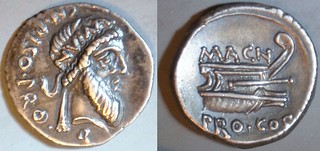
- RRC447 Pompey Varro.
Woytek: Dyrrachium early 48BC (Crawford: Greek travelling mint 49BC)


- RRC452 Caesar.
Woytek: Apollonia early - mid 48BC (Crawford: unknown travelling mint July 48C - 47BC)
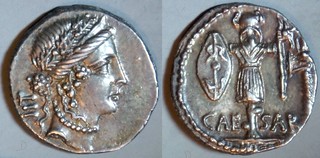



- RRC458 Caesar.
Woytek Asia 48-47 BC (Crawford: Africa 47-46 BC)
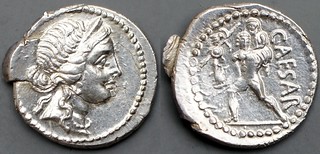
- RRC467 Caesar.
Woytek: Sicily 46BC (Crawford: uncertain 46BC)

- RRC475 Caesar Plautia.
Woytek: Rome late 46BC - early 45BC (Crawford: Rome 45BC)


- RRC476 Clovia.
Woytek Rome late 46 - early 45 BC (Crawford: uncertain 45BC)

- RRC477 Pompey Pietas.
Woytek: Southern Spain, camp mint, 44BC (Crawford: Spain Salpensa 45-44BC)


- RRC478 Pompey Eppius.
Woytek: Sicily at the end of 43BC (Crawford: Spain 45-44BC)

- RRC479 Pompey.
Woytek: Sicily 42-38BC, but a different mint than RRC478 (Crawford: Spain or Sicily up to 45BC)

- RRC483 Pompey Minatia.
Woytek: Sicily 42-38BC (Crawford: travelling mint, Marseille area 44-43 BC)

- RRC485,486,487 Flaminia Accoleia Petillia.
Woytek: Rome 41BC (Crawford: Rome 43BC)



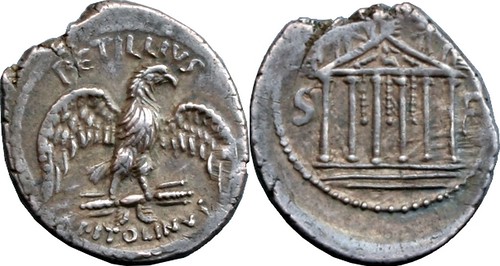
- RRC488 Julius Caesar and Mark Antony.
Woytek: Cisalpine Gaul late 43BC (Crawford: Transalpine & Cisalpine Gaul 43BC)


- RRC489/1-4 Lepidus and Mark Antony.
Woytek: Transalpine Gaul 43BC (Crawford: Transalpine or Cisalpine Gaul 43-42BC)

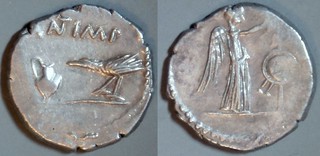
- RRC489/5-6 Mark Antony.
Woytek: Lugudunum RRC489/5: 43 BC; RRC489/6: 42BC (Crawford: Transalpine or Cisalpine Gaul 43-42BC)
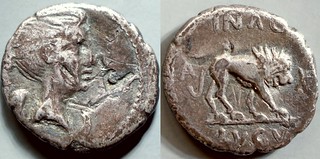

- RRC495 Lepidus and Octavian.
Woytek: Italy late 43BC (Crawford: Italy 42BC)

- RRC496/1/2 Mark Antony.
Woytek: camp mint Italy 42BC (Crawford: travelling mint 42BC possibly Buthrotum/Epirus)


- RRC496/3 Mark Antony.
Woytek: camp mint Greece 42BC (Crawford: travelling mint 42BC possibly Buthrotum/Epirus)

- RRC511 Sextus Pompey.
Woytek: Sicily 37-36BC (Crawford: Sicily 42-40BC)

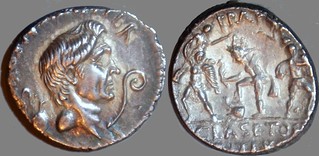
- RRC512,513,514,515 Clodia Arria Sulpicia Numonia.
Woytek: Rome 43BC (Crawford: Rome 41BC)






- RRC550 Oppia.
Woytek: Rome 46BC (Crawford: Laodiceia ad Lycum 88BC)

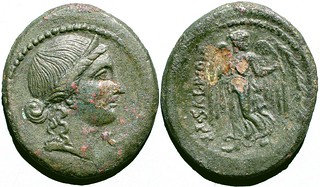
Imperatorial - Specialist Interest
Specialist studies on individual issues, Imperatorial period
Below are a number of definitive studies on the Imperatorial series. The Pietas article is reproduced in abridged version on this site. The short duration within which many of the issues were produced means that there can be little useful archaeological evidence to help classify the various issues. Pure numismatic studies, typically die analysis and sequencing, in combination with historical and typology studies, are used to support the various hypotheses. Unlike coinages that are supported by archaeological evidence, the database of evidence has not greatly improved over time with the exception of series that have been subject to die studies, notably those of the Pompey family. Hence older studies may still have merits, and each new case must be freshly argued. Woytek’s book above and Alföldi’s below are rare examples of syntheses that consider a wide range of coinages and not single issues. The coins of Pompey and family have been well addressed in a number of definitive die studies listed here. There appears to be a market gap for similar studies on Antony, and the tyrannicides, Brutus and Cassius.
- The Triumviral Portrait Gold of the Quattuorviri Monetales of 42 BC, T.V. Buttrey, ANS NNM 137, New York 1956
- The Pietas denarii of Sextus Pompey. T.V. Buttrey, Numismatic Chronicle 1960, abridged on this website.
- The denarius of Cn.Pompeius Jr. and M. Minatius Sabinus, T.V. Buttrey, ANS notes 9, 1960
- The Sicilian Coinage of Sextus Pompey (Crawford 511), J. de Rose-Evans, ANS notes 32, 1987
- Caesar’s Quattuorviri of 44BC, Colin Kraay, NC 1954. Many attempts have been made to arrange Caesar’s 44BC coins, notably Crawford and Alföldi. This 1956 study is the still the clearest, on a subject that has always been more about typology than archaeological evidence due to the short issue duration of the Crawford 480 Caesar portrait coins.
- The Portrait of Caesar on the Denarii of 44 B.C. and the Sequence of the Issues, A. Alföldi, in Centennial Publication of The American Numismatic Society. New York, 1958. An English monograph by Alföldi’s on the Caesar portrait coins, which however pre-dates by decades his definitive study in German, as well as pre-dating the proposal by Crawford within RRC. So, technically dated but of interest due the dearth of English language discussion on the subject.
- Q. Oppius P.R., E. Baden, ANS Notes 29, 1984. Provides further evidence supporting the 88BC date and Laodiceia ad Lycum mint for Q.Oppius orichalcum coins proposed by Crawford. However Grueber and Woytek take a different view, assigning them to Rome 46-45BC in parallel with the Clovius dupondius. Grant (FITA) and Sydenham propose 32BC in Laodiceia ad Lycum. I enjoy such controversies.
- Sicily and the Coinage of Octavian and Sextus Pompey: Aeneas or the Catanean brothers, E.M. Zarrow, NC 2003. Discusses types and motives on the Sicilian coinage of Octavian and Sextus Pompey.
- Monetazione bronzea romana tardo-repubblicana.- 1. Divos Iulius di Octavianus, “assi” di Sextus Pompeius, emissioni dei prefetti di Antonius. Rodolfo Martini 1988. A detailed study on Imperatorial bronzes by martini, covering the Divos Julius/Octavian series, and issues of Antony and prefects. The coins of Sextus Pompey are covered in more detail in volume 2:
- Monetazione bronzea romana tardo-repubblicana - 2. Sextus Pompeius. Rodolfo Martini, 1995. Colossal die-study of the CN.MAG, EPPIVS LEG and MAGN PIVS IMP bronze issues from Spain and Sicily. 300 pages text + 93 plates, including a die-link study with over 1000 photos. Analysis of the different issues (four distinct groups in the case of Cr479), mint locations etc. Also included is a brief study of his silver obverses, for comparison of titlature. A short English summary is included to aid navigation.
- The coinage of Bibulus again, by Michel Amandry in Essays Hersh 1998. A short catalogue of Bibulus’ fleet bronzes.

Octavian's Gold and Silver Coinage from 32 to 27 BC, CHV Sutherland, Quaderni Ticinesi 1976
This study underpins the RIC arrangement for the Caesar Divi F and Imp Caesar coins, provides evidence for the currently accepted dating, and has an interesting commentary on the paired-types arrangement. More useful than RIC itself. The pre-Actium coins are entirely omitted from Crawford (to place Crawford in good company these coins were likewise omitted from Sydenham). However in common with any study published in difficult to obtain journals and not reprinted in book format, I do not recommend you spend aeons searching for an obscure offprint because the series is well documented in HCRI. Of course the findings are also documented in RIC1, published by Sutherland in 1984, although RIC1 does not contain the 1976 QT text, instead, infuriatingly, refers to his own earlier study.
Caesar in 44 v. Chr. Volume I. Studien zur Caesars Monarchie und ihrer Wurzeln 1986; Volume II. Das Zeugnis der Münzen, Bonn. A. Alföldi.
Alföldi’s major study on the coinage of Julius Caesar. German. Volume 1 has 23 plates and addresses the roots of Caesar’s monarchical rule and coinage symbols relating to such power, both coins of Caesar as well as general coinages of Rome. Volume 2 has 156 plates focussing on his portrait coins. Not yet reviewed
La Monnaie de Rome a la fin de la Republique, Christine Perez, 1989
Discussion of coin types in the late Republic, illustrated with mediocre pictures from the Bourgey archive. French. The book fills a useful niche – a consistent theme in modern numismatics is a tendency to take typology for granted as related research dates back hundreds of years. Inexpensive and in print.
Political Propoganda in the Coinage of the Late Roman Republic, Leslaw Morawiecki, 1983
A short book that discusses the types and propaganda role of a range of Imperatorial issues. Interesting. English language material on this subject is in short supply, as the two definitive studies by Alföldi and Woytek are both in German, so this fills a niche.
Numismatic Fine Arts XXII June 1989
Contains an extensive synthesis of post-Crawford research on Roman Republican gold. The numismatic discussion is in many cases also relevant to silver coins from the same Crawford series.
Essays in Coinage presented to Harold Mattingly, R.A.G. Carson, C.H.V. Sutherland, 1956.
Although an older book this contains several essays that are still of interest as they deal mainly with typology rather than dating. Alföldi on political propoganda in the late Republic. Pink on the Triumviri Monetales. Additionally some general articles on Roman coins e.g. Toynbee on allegories, symbols, and personifications, that are relevant to all periods. Also contains a bibliography of works by Mattingly.
All content copyright © 2004-2011 Andrew McCabe unless otherwise noted. If you've any questions or comments please contact me on the Yahoo Group RROME: http://groups.yahoo.com/group/RROME.
Alternately you can leave comments against any coin picture, just click on the picture and write in the comment box.
See my rarity estimates for Roman Republican Bronzes: Roman Republic Bronze Rarities..